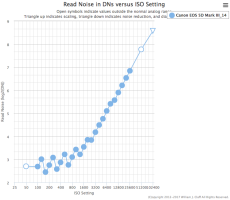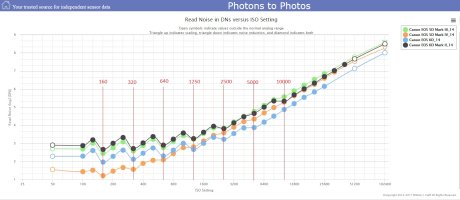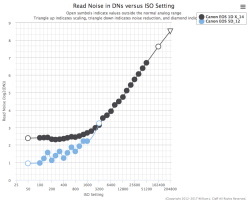It seems that the ISO 50 setting on Canon cameras seems to give mixed results depending on the camera. Hopefully others can get similar positive results with their cameras as I have gained.
With some cameras there is INCREASED dynamic range compared to ISO 100.
Some cameras have exactly the same dynamic range as ISO 100.
Some cameras have LESS dynamic range than ISO 100.
You can take a look at this chart to see where your camera stands:
http://www.photonstophotos.net/Charts/PDR.htm
Before we even start this discussion, we need to differentiate two very different things:
1) RAW dynamic range of the image sensor when taking an identical exposure at ISO 50 and ISO 100 (NOT making the ISO 50 exposure twice as long/bright)
2) The camera metering system and how it chooses to expose images when you set ISO 50 or ISO 100.
I'm talking about situation #1.
It seems that my ancient 1D mark II is one of the fewer cameras to have a very slight boost in dynamic range at ISO 50.
VERIFYING WITH MY OWN TESTS:
https://giphy.com/gifs/26zzic5iyRLhTRTy0/fullscreen
Here are the same 100% crops as above, but in lossless PNG:
https://ibb.co/nMwxqQ ISO 50
https://ibb.co/ihcgH5 ISO 100
Here you can see the increased dynamic range of the ISO 50 image when both images were exposed identically.
That's an extra 0.18 stops according to photonstophotos.net
How I did the test:
1) Manually set the exposure of both images (ISO 50 and ISO 100) at F5.6 and 1/25 - purposely overexposing the whole image by about two stops (I want clipped highlights for the test, I don't shoot like this normally!)
*NOTE: The ISO 50 exposure is 0.7 stops darker than the ISO 100 image (not 1 stop!).
2) Reduce exposure of both images in adobe camera raw... ISO 50 image by 2 stops, and ISO 100 image by 2.7 stops to get equal brightness.
3) highlights slider set to -100 for both images.
Please note that both images have all the possible highlight detail recovered.... going to even more exposure compensation does not get more detail.
That's it... and you can see what the extra 0.18 stops gets you... a tiny bit more recoverable detail... hehe.
REAL WORLD APPLICATION:
The workflow for getting this extra dynamic range is quite simple, but goes against what the camera manufacturer has done, since Canon's aim with ISO 50 is less noise by overexposing by one stop.
1) Set -1.0 exposure compensation on camera (camera will meter as if shooting ISO 100).
2) When importing your images... just set exposure compensation to +0.7... and your exposure will match the brightness of a normal ISO 100 exposure. This one-click step can be set for hundreds of images at the same time... so there is no extra time spent.
WHAT ABOUT THE SHADOWS?
I have done various tests and can find no noise/color penalty/advantage of any kind by shooting ISO 50 vs ISO 100.
TOO LONG, DIDNT READ... & CONCLUSION:
Setting ISO 50 on my camera with the same exposure as ISO 100 gets me the following:
HIGHLIGHTS: 0.18 stops of extra highlight detail (increased dynamic range).
SHADOWS: No benefits and no disadvantages.... they are identical.
.... and if you're really bored... check the original raw files for yourself
http://www119.zippyshare.com/v/GqHFSvGQ/file.html
http://www119.zippyshare.com/v/fvJKEill/file.html
With some cameras there is INCREASED dynamic range compared to ISO 100.
Some cameras have exactly the same dynamic range as ISO 100.
Some cameras have LESS dynamic range than ISO 100.
You can take a look at this chart to see where your camera stands:
http://www.photonstophotos.net/Charts/PDR.htm
Before we even start this discussion, we need to differentiate two very different things:
1) RAW dynamic range of the image sensor when taking an identical exposure at ISO 50 and ISO 100 (NOT making the ISO 50 exposure twice as long/bright)
2) The camera metering system and how it chooses to expose images when you set ISO 50 or ISO 100.
I'm talking about situation #1.
It seems that my ancient 1D mark II is one of the fewer cameras to have a very slight boost in dynamic range at ISO 50.
VERIFYING WITH MY OWN TESTS:
https://giphy.com/gifs/26zzic5iyRLhTRTy0/fullscreen
Here are the same 100% crops as above, but in lossless PNG:
https://ibb.co/nMwxqQ ISO 50
https://ibb.co/ihcgH5 ISO 100
Here you can see the increased dynamic range of the ISO 50 image when both images were exposed identically.
That's an extra 0.18 stops according to photonstophotos.net
How I did the test:
1) Manually set the exposure of both images (ISO 50 and ISO 100) at F5.6 and 1/25 - purposely overexposing the whole image by about two stops (I want clipped highlights for the test, I don't shoot like this normally!)
*NOTE: The ISO 50 exposure is 0.7 stops darker than the ISO 100 image (not 1 stop!).
2) Reduce exposure of both images in adobe camera raw... ISO 50 image by 2 stops, and ISO 100 image by 2.7 stops to get equal brightness.
3) highlights slider set to -100 for both images.
Please note that both images have all the possible highlight detail recovered.... going to even more exposure compensation does not get more detail.
That's it... and you can see what the extra 0.18 stops gets you... a tiny bit more recoverable detail... hehe.
REAL WORLD APPLICATION:
The workflow for getting this extra dynamic range is quite simple, but goes against what the camera manufacturer has done, since Canon's aim with ISO 50 is less noise by overexposing by one stop.
1) Set -1.0 exposure compensation on camera (camera will meter as if shooting ISO 100).
2) When importing your images... just set exposure compensation to +0.7... and your exposure will match the brightness of a normal ISO 100 exposure. This one-click step can be set for hundreds of images at the same time... so there is no extra time spent.
WHAT ABOUT THE SHADOWS?
I have done various tests and can find no noise/color penalty/advantage of any kind by shooting ISO 50 vs ISO 100.
TOO LONG, DIDNT READ... & CONCLUSION:
Setting ISO 50 on my camera with the same exposure as ISO 100 gets me the following:
HIGHLIGHTS: 0.18 stops of extra highlight detail (increased dynamic range).
SHADOWS: No benefits and no disadvantages.... they are identical.
.... and if you're really bored... check the original raw files for yourself
http://www119.zippyshare.com/v/GqHFSvGQ/file.html
http://www119.zippyshare.com/v/fvJKEill/file.html



